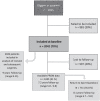Patient-Reported Outcome, Return to Sport, and Revision Rates 7-9 Years After Anterior Cruciate Ligament Reconstruction: Results From a Cohort of 2042 Patients
- PMID: 35040694
- PMCID: PMC8829731
- DOI: 10.1177/03635465211060333
Patient-Reported Outcome, Return to Sport, and Revision Rates 7-9 Years After Anterior Cruciate Ligament Reconstruction: Results From a Cohort of 2042 Patients
Abstract
Background: Long-term patient-reported outcome measures (PROMs), rates of return to sport, and revision risk after anterior cruciate ligament (ACL) reconstruction (ACLR) are not well understood.
Purpose: To provide long-term follow-up of PROMs, return-to-sport rates, and revision rates after ACLR and to identify predictors for poor outcome.
Study design: Case-control study; Level of evidence, 3.
Methods: A total of 2042 patients were included in an institutional ACL registry (2009-2013) and longitudinally followed. PROMs were completed preoperatively and at all follow-up time points. Questions regarding return to sport and knee stability were completed at final follow-up. Predictors for poor outcome on the International Knee Documentation Committee (IKDC) score were estimated in a regression model incorporating risk factors such as patient characteristics, graft choice, and concomitant injuries. Revision rates and risk of subsequent non-ACL surgeries were calculated.
Results: Autografts were used in 76% of the patients (patellar tendon, 62%; hamstring grafts, 38%). Allografts were used in 24% of patients. The questionnaires were returned by 1045 (51.2%) patients at a mean of 7.2 years (range, 5.0-9.8 years) after surgery. Improvements in IKDC score of >30 points were sustained for all patient categories. The strongest predictor for lesser improvement in IKDC score was a cartilage lesion >2 cm2 identified during surgery. Male sex and college education completion were associated with improved IKDC scores. Meniscal lesions did not predict change) in the IKDC score. A total of 69% of patients had returned to sport after 8.1 years (range, 6.7-9.8 years). The main reason for not returning to sport was fear of reinjury. The revision rate was 7.2% after 9 years (range, 8-11 years), 13% of patients needed subsequent ipsilateral non-ACL surgery, and 6% underwent contralateral ACLR. The absence of a meniscal tear, younger age, and male sex were predictors for revision. Graft choice did not predict PROM results or revision risk.
Conclusion: Improvements in IKDC scores were sustained 7 years after ACLR. The strongest predictor for poor outcome was a cartilage lesion >2 cm2. Patients can expect a 70% return-to-sport rate and an 87% chance of their knee feeling stable during daily and athletic activities after 8 years. Young male patients have better PROM scores but a higher risk of revision. There is a 26% chance of subsequent knee surgery within 9 years, including a revision rate of 7%, subsequent non-ACL surgery to the operated knee in 13%, and a 6% chance of contralateral ACLR.
Keywords: ACL; IKDC; return to sport; revision.
Conflict of interest statement
One or more of the authors has declared the following potential conflict of interest or source of funding: A.R. has received consulting fees from Anika Therapeutics, Bodycad USA, Smith & Nephew, Arthrex, Flexion Therapeutics, Stryker, and Heron Therapeutics; royalties from ConforMIS; education support from Gotham Surgical Solutions; and other from Enhatch, Xiros, NewClip, Ranfac, and Marrow Cellution; he also has family members with disclosures for Strathspey Crown and DePuy. A.D.P. has received consulting fees from Zimmer Biomet, Exactech, and Stryker; royalties from Zimmer Biomet; hospitality payments from Smith & Nephew; education support from Arthrex; and other from Engage Surgical. S.A.R. has received royalties from Zimmer Biomet; consulting fees from Advance Medical, Flexion Therapeutics, and Novartix Pharmaceutical; and income from the sale of Rotation Medical to Smith & Nephew (from stock options) and the sale of Cayenne Medical to Zimmer (from stock options); he is an associate editor for
Figures


References
-
- Andernord D, Desai N, Bjornsson H, et al.. Patient predictors of early revision surgery after anterior cruciate ligament reconstruction: a cohort study of 16,930 patients with 2-year follow-up. Am J Sports Med. 2015;43(1):121-127. - PubMed
-
- Andernord D, Desai N, Bjornsson H, et al.. Predictors of contralateral anterior cruciate ligament reconstruction: a cohort study of 9061 patients with 5-year follow-up. Am J Sports Med. 2015;43(2):295-302. - PubMed
-
- Chalmers PN, Mall NA, Moric M, et al.. Does ACL reconstruction alter natural history? A systematic literature review of long-term outcomes. J Bone Joint Surg Am. 2014;96(4):292-300. - PubMed
MeSH terms
Grants and funding
LinkOut - more resources
Full Text Sources
Medical

